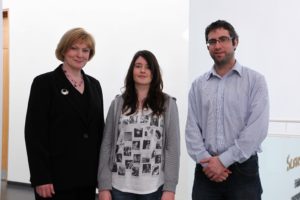 An IT Sligo lecturer who was part of an award winning conservation project in the Burren, is now hoping that a similar plan can be adopted to protect endangered habitats on the Aran Islands.
An IT Sligo lecturer who was part of an award winning conservation project in the Burren, is now hoping that a similar plan can be adopted to protect endangered habitats on the Aran Islands.
Dr James Moran, lecturer in ecology and environmental science at IT Sligo, was involved in the BurrenLIFE project which was selected by the EU as one of the top six “Best of Best” LIFE Nature projects for 2010. The prestigious award was described by Arts, Heritage and Gaeltacht Minister Jimmy Deenihan TD as “a great honour for the country”.
The BurrenLIFE Project involved farmers, scientists and conservationists working together to develop a new sustainable farming model for the Burren. The objective was to protect the habitats, flora, fauna and archaeological heritage, while also ensuring that local farmers maintain a livelihood.
Dr Moran explained that the unique landscape of the Burren, which is so revered by tourists, was being threatened by changes in farming practices. “Because farming was not viable many areas had effectively been abandoned or were not being grazed,” he explained. This meant that dead vegetation was not being removed and grass was slowly being replaced by scrub to the detriment of many rare species including plants, butterflies and other important pollinating insects such as bees.
Initially 20 farmers were involved but over 100 are now participating in the Burren Farming for Conservation Programme, and nearly 13,000ha of Special Areas of Conservation (SACs) are being managed to improve their conservation status.
Dr Moran believes that there is similar potential for protecting priority habitats on the three Aran Islands. Along with colleagues from the Heritage Council and the European Forum on Nature Conservation and Pastoralism, he has recently completed an EU LIFE Nature application for funding. Through this application process the project partners brought together a range of government agencies and departments (Údarás na Gaeltachta, Teagasc, National Parks and Wildlife Service, Galway Co. Co., Fáilte Ireland and the Heritage Council), and the local farming community under a common goal to achieve sustainable management of the islands’ rich natural heritage.
“The Aran islands have been ranked 11 out of over 100 top world island destinations by National Geographic”, he explained. “An estimated 200,000 people visit the islands every year and the majority go for the landscape and the cultural experience”.
With almost 75 per cent of the islands protected under the EU habitats Directive, Dr Moran believes that the landscape on the Aran Islands is also under threat, just as the Burren was.
“Many of the problems are similar – land has been abandoned and the limestone pavement is disappearing under scrub,” he explained.
Pamela Boyle from Swinford in Co Mayo is one of Dr Moran’s PhD students at IT Sligo. In collaboration with researchers at NUIG (Margaret Hayes and Dr. Mike Gormally), she is investigating the potential for High Nature Value (HNV) farming in the North West. HNV farming, so vital in protecting areas like the Burren, protects biodiversity by, for example, using low density farming methods. The researchers, who have already identified a study area in Co Mayo, will investigate land use issues such as land abandonment, farm intensification and ecosystem services (clean air, water, biodiversity and scenic landscapes) provision by farmers.
The research project is being funded with the help of an IT Sligo President’s Bursary Award. For more information on IT Sligo see www.itsligo.ie.
Image Caption: Dr James Moran pictured with the President of IT Sligo, Professor Terri Scott, and PhD student Pamela Boyd from Swinford in Co Mayo.